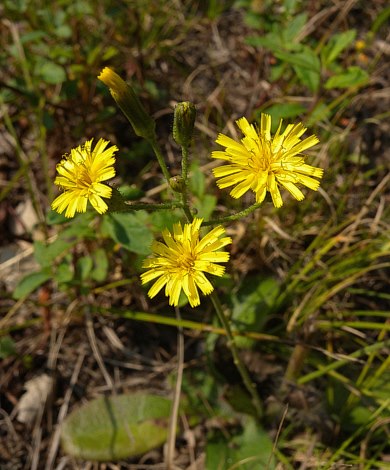Plants 30-45(-80) cm. Stems proximally piloso-hirsute (hairs 2-4+ mm), sometimes stellate-pubescent as well, distally stellate-pubescent, sometimes piloso-hirsute as well. Leaves: basal 0(-2+), cauline (3-)6-12+; blades elliptic or obovate to oblanceolate, 20-35(-90) × 10-40(-50) mm, lengths 2-4+ times widths, bases cuneate to rounded (sometimes ± clasping), margins entire, apices rounded to acute, abaxial faces piloso-hirsute (hairs 2-4 mm) and stellate-pubescent, adaxial piloso-hirsute. Heads (5-)25-50 in usually narrow, thyrsiform arrays (lengths of arrays usually 3-6+ times diams., sometimes shorter). Peduncles stellate-pubescent and stipitate-glandular. Calyculi: bractlets 8-12+. Involucres cylindric to campanulate, 7-10 mm. Phyllaries 12-15+, apices rounded to acute or acuminate, abaxial faces glabrous or stellate-pubescent, rarely stipitate-glandular as well. Florets 12-20+; corollas yellow, 8-9+ mm. Cypselae urceolate, 3.5-4.5+ mm; pappi of ca. 40+, stramineous bristles in 2+ series, ca. 5 mm.
Flowering (Mar-)Jul-Sep(-Oct). Openings in pine and pine-oak woods, bogs, sands; 30-600 m; Ont.; Ala., Ark., Conn., Del., D.C., Fla., Ga., Ill., Ind., Kans., Ky., La., Maine, Md., Mass., Mich., Minn., Miss., Mo., N.J., N.Y., N.C., Ohio, Okla., Pa., R.I., S.C., Tenn., Tex., Va., W.Va.; Mexico, Central America.
Infrequent to frequent in the lake area, infrequent in the southern part of the state, and local, rare or absent in many of the counties in the Tipton Till Plain where the soil is too alkaline for it. It seems to prefer a slightly acid soil and this fact accounts for its being found on washed wooded slopes, interdunal flats, and the hard, white, sandy, clay loam of the Illinoian drift. Fernald & Griscom (Rhodora 37: 185-186. 1935) report a variety of this species, var. foliosum Michx., as being found in southern Indiana. The variety is described as having more cauline leaves which extend nearly to the inflorescence. We have a few plants answering this description, but I do not regard them as worthy of a varietal name. The cauline leaves on our plants vary from few to many, the variation apparently due, for the most part, to nutrition. I have seen very vigorous and large plants that exceeded the size of average plants, growing in moist, clay soil in fallow fields. The plant is highly variable even as to the number of achenes. Since I am not recognizing this variety, its distribution in the state is not given, although I have specimens from the northern to the southern border.
Stems mostly solitary on a crown or short, praemorse rhizome, 3-15 dm, conspicuously spreading-hairy toward the base, the hairs rarely approaching 1 cm, becoming merely strigose-puberulent or obscurely stellate to subglabrous upward, sometimes also finely glandular; lvs finely stellate and usually also ±long-hairy, the basal or lowest cauline ones broadly oblanceolate to obovate or elliptic, 4-20 cm (including the usually short petiole) נ1-2.5 cm, deciduous or persistent, the cauline ones progressively reduced upward, soon becoming sessile and commonly somewhat clasping, the upper part of the stem naked or nearly so; infl ±elongate and openly cylindric, at least in well developed plants; the peduncles puberulent and sparsely to fairly copiously long-stipitate-glandular; invol 6-9 mm; fls 20-40; achenes 2.5-4 mm, distinctly narrowed toward the top; 2n=18. Dry, open woods, especially in sandy soil, sometimes fields and pastures; Mass. to Fla., w. to s. Ont., Kans., and Tex. July-Oct.
Gleason, Henry A. & Cronquist, Arthur J. 1991. Manual of vascular plants of northeastern United States and adjacent Canada. lxxv + 910 pp.
©The New York Botanical Garden. All rights reserved. Used by permission.





